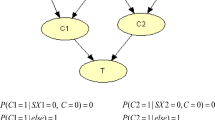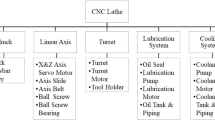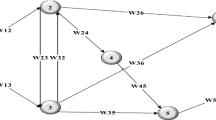Abstract
Precise monitoring, diagnosis, and control of subtractive machines like turning centers are challenging tasks in automated manufacturing industries. To identify the failures in a subsystem of a turning center, all the required parameters need to be recorded, stored, and retrieved systematically for effective monitoring and control. In this work, the experimental data of a CNC turning center available in a repository are classified with interval type 2 fuzzy logic system (IT2FLS) using semi-elliptic membership function (SEMF) to predict the risk state of each subsystem. The geomantic property of SEMF has shown faster convergence and less computation load. The simulated results of each subsystem governed by the SEMF are compared with Gaussian membership function (GMF) to evaluate its potential. The research out comes confirms that the computation load of IT2FLS is considerably reduced based on the implementation of Wu–Mendel uncertainty bounds.














Similar content being viewed by others
References
Wainer, H.: Eelworms, Bullet Holes, and Geraldine Ferraro some problems in statistically adjusting for survey nonresponse. ETS Res. Rep. Ser. 1(1), i–19 (1987). https://doi.org/10.1002/j.2330-8516.1987.tb00216.x
Mittal, K., Jain, A., Vaisla, K.S., Castillo, O., Kacprzyk, J.: A comprehensive review on type 2 fuzzy logic applications: past, present and future. Eng. Appl. Artif. Intell. 95(September), 103916 (2020). https://doi.org/10.1016/j.engappai.2020.103916
Shukla, A.K., Banshal, S.K., Seth, T., Basu, A., John, R., Muhuri, P.K.: A bibliometric overview of the field of type-2 fuzzy sets and systems [discussion forum]. IEEE Comput. Intell. Mag. 15(1), 89–98 (2020). https://doi.org/10.1109/MCI.2019.2954669
Castillo, O., Muhuri, P.K., Melin, P., Pulkkinen, P.: Emerging issues and applications of type-2 fuzzy sets and systems. Eng. Appl. Artif. Intell. 90, 2–4 (2020). https://doi.org/10.1016/j.engappai.2020.103596
Mendel, J.M.: Type-2 fuzzy sets and systems: an overview. IEEE Comput. Intell. Mag. 2(1), 20–29 (2007). https://doi.org/10.1109/MCI.2007.380672
Wu, H., Mendel, J.M.: Uncertainty bounds and their use in the design of interval type-2 fuzzy logic systems. IEEE Trans. Fuzzy Syst. 10(5), 622–639 (2002). https://doi.org/10.1109/TFUZZ.2002.803496
Liu, F.: An efficient centroid type-reduction strategy for general type-2 fuzzy logic system. Inf. Sci. (Ny) 178(9), 2224–2236 (2008). https://doi.org/10.1016/j.ins.2007.11.014
Mendel, J.M.: Computing derivatives in interval type-2 fuzzy logic systems. IEEE Trans. Fuzzy Syst. 12(1), 84–98 (2004). https://doi.org/10.1109/TFUZZ.2003.822681
Ontiveros, E., Melin, P., Castillo, O.: Comparative study of interval type-2 and general type-2 fuzzy systems in medical diagnosis. Inf. Sci. (Ny) 525, 37–53 (2020). https://doi.org/10.1016/j.ins.2020.03.059
Castillo, O., Amador-Angulo, L.: A generalized type-2 fuzzy logic approach for dynamic parameter adaptation in bee colony optimization applied to fuzzy controller design. Inf. Sci. (Ny) 460–461, 476–496 (2018). https://doi.org/10.1016/j.ins.2017.10.032
Fazel Zarandi, M.H., Soltanzadeh, S., Mohammadi, A., Castillo, O.: Designing a general type-2 fuzzy expert system for diagnosis of depression. Appl. Soft Comput. J. 80(2019), 329–341 (2019). https://doi.org/10.1016/j.asoc.2019.03.027
Castillo, O., Cervantes, L., Soria, J., Sanchez, M., Castro, J.R.: A generalized type-2 fuzzy granular approach with applications to aerospace. Inf. Sci. (Ny) 354, 165–177 (2016)
Muhuri, P.K., Shukla, K.K.: Real-time task scheduling with fuzzy uncertainty in processing times and deadlines. Appl. Soft Comput. J. 8(1), 1–13 (2008). https://doi.org/10.1016/j.asoc.2006.06.006
Khanesar, M.A., Kayacan, E., Teshnehlab, M., Kaynak, O.: Analysis of the noise reduction property of type-2 fuzzy logic systems using a novel type-2 membership function. IEEE Trans. Syst. Man Cybern. Part B Cybern. 41(5), 1395–1406 (2011). https://doi.org/10.1109/TSMCB.2011.2148173
Masumpoor, S., Yaghobi, H., Ahmadieh Khanesar, M.: Adaptive sliding-mode type-2 neuro-fuzzy control of an induction motor. Expert Syst. Appl. 42(19), 6635–6647 (2015). https://doi.org/10.1016/j.eswa.2015.04.046
Muhuri, P.K., Shukla, A.K.: Semi-elliptic membership function: representation, generation, operations, defuzzification, ranking and its application to the real-time task scheduling problem. Eng. Appl. Artif. Intell. 60(May 2016), 71–82 (2017). https://doi.org/10.1016/j.engappai.2016.12.020
Kayacan, E., Sarabakha, A., Coupland, S., John, R.: “Type-2 fuzzy elliptic membership functions for modeling uncertainty. Eng. Appl. Artif. Intell. 70(2017), 170–183 (2018). https://doi.org/10.1016/j.engappai.2018.02.004
Dutta, P., Saikia, B.: Arithmetic operations on normal semi elliptic intuitionistic fuzzy numbers and their application in decision-making. Granul. Comput. (2019). https://doi.org/10.1007/s41066-019-00175-5
Shukla, A.K., Muhuri, P.K.: Big-data clustering with interval type-2 fuzzy uncertainty modeling in gene expression datasets. Eng. Appl. Artif. Intell. 77(July 2018), 268–282 (2019). https://doi.org/10.1016/j.engappai.2018.09.002
Dutta, P.: Mathematics of uncertainty: an exploration on semi-elliptic fuzzy variable and its properties. SN Appl. Sci. (2020). https://doi.org/10.1007/s42452-019-1871-8
Vashisth, P., Khurana, P., Bedi, P.: A fuzzy hybrid recommender system. J. Intell. Fuzzy Syst. 32(6), 3945–3960 (2017). https://doi.org/10.3233/JIFS-14538
Ding, S., Huang, X., Ban, X., Lu, H., Zhang, H.: Type-2 fuzzy logic control for underactuated truss-like robotic finger with comparison of a type-1 case 1. J. Intell. Fuzzy Syst. 33(4), 2047–2057 (2017). https://doi.org/10.3233/JIFS-161538
Kececioglu, O.F.: Robust control of high gain DC-DC converter using Type-2 fuzzy neural network controller for MPPT. J. Intell. Fuzzy Syst. 37(1), 941–951 (2019). https://doi.org/10.3233/JIFS-181770
Eyoh, I.J., Umoh, U.A., Inyang, U.G., Eyoh, J.E.: Derivative-based learning of interval type-2 intuitionistic fuzzy logic systems for noisy regression problems. Int. J. Fuzzy Syst. 22(3), 1007–1019 (2020). https://doi.org/10.1007/s40815-020-00806-z
Xu, X., Su, P., Wang, F., Chen, L., Xie, J., Atindana, V.A.: Coordinated control of dual-motor using the interval type-2 fuzzy logic in autonomous steering system of AGV. Int. J. Fuzzy Syst. (2020). https://doi.org/10.1007/s40815-020-00886-x
Zhao, T., Yu, Q., Dian, S., Guo, R., Li, S.: Non-singleton general type-2 fuzzy control for a two-wheeled self-balancing robot. Int. J. Fuzzy Syst. 21(6), 1724–1737 (2019). https://doi.org/10.1007/s40815-019-00664-4
Huynh, T.T., et al.: A new self-organizing fuzzy cerebellar model articulation controller for uncertain nonlinear systems using overlapped Gaussian membership functions. IEEE Trans. Ind. Electron. 67(11), 9671–9682 (2020). https://doi.org/10.1109/TIE.2019.2952790
Cuevas, F., Castillo, O., Cortes-Antonio, P.: Optimal Design of Interval Type-2 Fuzzy Tracking Controllers of Mobile Robots Using a Metaheuristic Algorithm, pp. 315–341. Springer, Cham (2021)
Seth, T., Muhuri, P. K.: Type-2 fuzzy set based hesitant fuzzy linguistic term sets for linguistic decision making. (2020). arXiv preprint arXiv:2002.11714
Tolga, A.C., Parlak, I.B., Castillo, O.: Finite-interval-valued type-2 Gaussian fuzzy numbers applied to fuzzy TODIM in a healthcare problem. Eng. Appl. Artif. Intell. 87(2019), 103352 (2020). https://doi.org/10.1016/j.engappai.2019.103352
Sreekumar, M.: A robot manipulator with adaptive fuzzy controller in obstacle avoidance. J. Inst. Eng. Ser. C 97(3), 469–478 (2016). https://doi.org/10.1007/s40032-015-0215-8
Sreekumar, M., Nagarajan, T., Singaperumal, M., Zoppi, M., Molfino, R.: Training of a fuzzy logic controller using table lookup scheme for the control of SMA actuators”. Int. J. Math. Sci. 5(2), 335–353 (2006)
Chen, J., Rine, D.C.: Training fuzzy logic controller software components by combining adaptation algorithms. Adv. Eng. Softw. 34(3), 125–137 (2003). https://doi.org/10.1016/S0965-9978(02)00140-0
Khater, A.A., El-Nagar, A.M., El-Bardini, M., El-Rabaie, N.M.: Online learning of an interval type-2 TSK fuzzy logic controller for nonlinear systems. J. Franklin Inst. 356(16), 9254–9285 (2019). https://doi.org/10.1016/j.jfranklin.2019.08.031
Mendel, J.M.: A quantitative comparison of interval type-2 and type-1 fuzzy logic systems: First results. 2010 IEEE World Congr. Comput. Intell. WCCI 2010 (2010). https://doi.org/10.1109/FUZZY.2010.5584727
Wu, D.: Twelve considerations in choosing between Gaussian and trapezoidal membership functions in interval type-2 fuzzy logic controllers. IEEE Int. Conf. Fuzzy Syst. (2012). https://doi.org/10.1109/FUZZ-IEEE.2012.6251210
Prasad, B.S., Rao, J.U., Krishna, A.G.: Analysis of vibration signals to quantify displacement amplitude in the monitoring of vibration-assisted turning. Proc. Inst. Mech. Eng. Part E J. Process Mech. Eng. 233(1), 35–47 (2019). https://doi.org/10.1177/0954408917742196
El-Bouri, W., Deiab, I., Khanafer, K., Wahba, E.: Numerical and experimental analysis of turbulent flow and heat transfer of minimum quantity lubrication in a turning process using discrete phase model. Int. Commun. Heat Mass Transf. 104, 23–32 (2019). https://doi.org/10.1016/j.icheatmasstransfer.2019.02.012
Angadi, S.V., et al.: Reliability and life study of hydraulic solenoid valve. Part 2: experimental study. Eng. Fail. Anal. 16(3), 944–963 (2009). https://doi.org/10.1016/j.engfailanal.2008.08.012
Penman, J., Sedding, H.G., Lloyd, B.A., Fink, W.T.: Detection and location of interturn short circuits in the stator windings of operating motors. IEEE Trans. Energy Convers. 9(4), 652–658 (1994). https://doi.org/10.1109/60.368345
Mendel, J.M.: Uncertain Rule-Based Fuzzy Systems. Springer, Cham (2017)
Acknowledgements
The authors sincerely thank the Ministry of Electronics and Information Technology (MeitY), Government of India, for providing financial assistance under Visvesvaraya PhD Scheme (MEITY-PHD-1558) to carry out this research work at IIITDM Kancheepuram, Chennai, India.
Author information
Authors and Affiliations
Corresponding author
Rights and permissions
About this article
Cite this article
Badri Narayanan, K.B., Sreekumar, M. Diagnosing of Risk State in Subsystems of CNC Turning Center using Interval Type-2 Fuzzy Logic System with Semi Elliptic Membership Functions. Int. J. Fuzzy Syst. 24, 823–840 (2022). https://doi.org/10.1007/s40815-021-01172-0
Received:
Revised:
Accepted:
Published:
Issue Date:
DOI: https://doi.org/10.1007/s40815-021-01172-0




